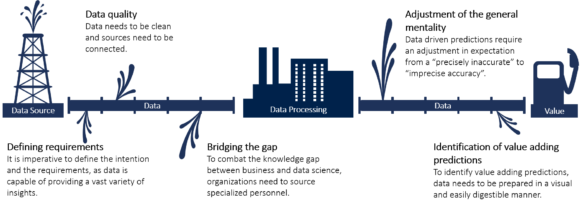While the growing availability of data provides the potential for greatly increased quality and efficiency in controlling, effectively using this opportunity proves to be difficult in many cases. The following article introduces the potentials of predictive analytics in controlling and builds the basis for further explorations and blog articles on the topic.
In the year 2006, the mathematician Clive Humby coined the quote “Data is the new oil”, which perfectly encapsulates the potential inherent in today’s data. Although equating oil to data might make sense regarding the potential for profit, there is a large discrepancy in how easy it is to reach this potential. While there is straight forward process behind generating the value out of oil, things are more complex when it comes to data. Retrieving data potential is highly reliant on business requirements, the tools available, and the data itself.
How can data analytics find the oil within financial data?
Data science provides the processing power to transform data into value. Within the last years, data science rapidly evolved, enriching and expanding existing statistical theories and methods with the newest capabilities of technology. The implementation of AI-based algorithms and automation unlocks new potentials within company functions and enables the focus on value generation instead of information processing. This change has massive potential in most traditional company functions, but is still often overlooked within finance, regardless of sources estimating as much as 79% of the work within certain finance functions being automatable (Plaschke, Seth & Whiteman, 2018).
Financial data is made for analytics – it is plentiful and highly structured; the output of controlling functions are figures that serve as the basis for management decisions, and even controllers often are already familiar with analytical methods. Existing implementations of data analytics in the controlling loop have started to change the historically reactive nature of this function into a proactive, value-generating unit. The ever-expanding toolset available constantly increases the potential within this transformation. But how can data analytics be implemented to further drive this transformation in controlling?
Data analytics can be categorized in the following broad categories, which are closely connected: descriptive analytics, diagnostic analytics, predictive analytics and prescriptive analytics:
Predictive analytics is rarely seen as a separate entity, but as a crucial building block in the bigger ecosystem of data analytics, which is generally directly linked to improvements in process efficiency, improved decision quality and quantitative improvements.
Data analytics provides a variety of use cases, which directly and indirectly impact controlling. The following section introduces some of the most promising use cases in this area.
-
Anomaly detection
While humans struggle with the identification of outliers within data on more than two-dimensions, data analytics is capable of fast identification of abnormal structures within huge data sets. This allows for early identification of problematic data points that could lead to unexpected deviations in end-of-month-statements or even the early identification of hidden fraud.
-
Segmentation
To provide a deeper understanding of one’s customers, suppliers and other stakeholders, proper clustering is crucial. Controlling activities based on inefficient and misleading aggregates can lead to inaccurate conclusions. Data analytics can alleviate the issue by identifying unintuitive segments within the stakeholder-base, allowing for improved steering measurements for the controller.
-
Forecasting
Applying predictive analytics to the planning processes provides the most obvious advantages. With the amount of data available it becomes increasingly difficult to identify relevant information and derive the appropriate conclusions. Algorithms have a higher capability to process data and visualize them in an easily digestible manner. Predictive analytics expands on this, automatically processes this data and provides the controller with trends, models, and precise predictions. This can be achieved using traditional and well-known algorithms that are executed non-manually or through machine learning, which provides deep, but unintuitive insights.
The challenge in generating value from the new oil
While many CFOs have identified the potential of implementing these new analytics tools and methodologies, in practice it is hard to change the established controlling structures, as these changes can have cascading effect resulting in complications and inaccurate decision basis. To effectively implement such new methodologies, a variety of challenges need to be tackled.
Despite the complexity and challenges facing predictive analytics, its advantages are undeniable. Data analytics provides a deeper understanding of one’s data, providing insights on company stakeholders and anomalies. Beyond that and of interest to controlling, predictive analytics can improve all facets of forecasting, improving its efficiency, accuracy, and usability.
As a digital frontrunner with more than 20 years of experience in data and information management, CAMELOT possesses the expertise required to successfully incorporate data science and its advantages in your business. Our experience in delivering 10 PoCs exploring the newest technological developments provides us with the required knowledge to tackle projects pioneering data science and implementing such projects within any company.
This article is the second part of a series CAMELOT is publishing on the topic of analytics. In the following issues we will further explore the implications of data science and dive deeper into the topic of predictive analytics. Stay tuned.
We would like to thank Tizian Schubart for his valuable contribution to this article.



